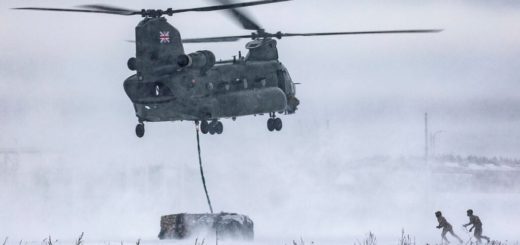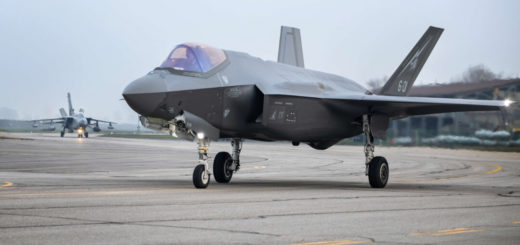Argentina Eyes KC-135 Stratotankers Aircraft to Boost F-16 Fleet Operational Capabilities


{loadposition bannertop}
Breaking news
{loadposition sidebarpub}
Argentina is progressing in its strategic development to enhance the operational capabilities of its air fleet by initiating the process to acquire Boeing KC-135 Stratotanker aerial refueling aircraft. This strategic move aims to extend the range of the recently acquired F-16 fighters of the Argentine Air Force (FAA).
/* 468×15 data sheet menu top dark green */
google_ad_slot = “3500417247”;
google_ad_width = 468;
google_ad_height = 15;
// ]]>
/* top_468x60_fiche_technique */
google_ad_slot = “2746785843”;
google_ad_width = 468;
google_ad_height = 60;
// ]]>
Boeing KC-135 Stratotanker Aerial Refueling Military Aircraft (Picture source: US DoD)
A detailed report submitted to the Argentine Senate by the Chief of Staff, Nicolás Posse, reveals that the FAA is seriously considering incorporating the KC-135 model. These refueling aircraft are necessary to complement the capabilities of the F-16s, especially since the two Lockheed Martin KC-130H Hercules aircraft currently in service are not compatible with in-flight refueling of the new F-16 MLU (Mid-Life Update) acquired from Denmark.
The report specifies that “the incorporation of KC-135 Stratotanker aircraft in Ramp to Ramp mode is envisaged as soon as these aircraft are available.” This choice demonstrates a desire to modernize and enhance the autonomy of the country’s air forces by enabling extended and more flexible operations, essential for defense and international projection of Argentina.
The need for these refueling aircraft is underscored by the remarks of the Joint Chief of Staff, Brigadier General Xavier Julián Isaac, at the last edition of FIDAE (International Air and Space Fair), where he mentioned that the integration of an in-flight refueling system for the F-16s will be “carefully analyzed, without haste,” taking into account the already substantial autonomy of the aircraft.
The acquisition process for the KC-135s is not yet finalized, and details regarding the timeline and specific arrangements remain unclear. The report indicates that administrative procedures are underway, marking the first steps of a project that could significantly strengthen the capabilities of the FAA.
This effort to acquire KC-135s is part of a broader context of modernization of the Argentine Air Force, which also includes improving infrastructure at the Tandil air base and the Río Cuarto Material Area. These improvements are essential to ensure the proper functioning and maintenance of the new F-16s, as well as to support future operations enhanced by the refueling aircraft.
The introduction of the KC-135 Stratotankers will represent a major advancement for Argentina, enabling it to support extended military operations and increase its presence on the international defense and security stage. Decisions made in the coming months will be crucial for the future operational capacity of the FAA.
The Boeing KC-135 Stratotanker, a mainstay of the United States aerial refueling fleet since its introduction in 1957, has undergone several phases of modernization to remain an effective platform for modern missions. Originally designed to refuel strategic bombers during the Cold War, the KC-135 has undergone significant updates over the decades. Among these improvements, replacing the original turbojet engines with CFM56 turbofan engines designed by CFM International marked a significant enhancement in efficiency and noise reduction. In addition to propulsion upgrades, the KC-135 has been equipped with modern avionics systems, enhancements to its navigation and communication systems, and upgrades to its combat survival capabilities. These modernizations have greatly increased the versatility and durability of the aircraft, allowing it to serve well beyond its originally anticipated operational lifespan.
Technically, the KC-135 stands out for its extensive aerial refueling capabilities. The aircraft is equipped with a rigid boom refueling system, allowing for the transfer of fuel at a rate of 1,000 gallons per minute, making it ideal for quick and efficient operations necessary to support aerial combat groups. Its maximum fuel capacity is about 200,000 pounds (90,700 kg), enabling it to refuel multiple aircraft without needing to return to base. The KC-135 can also be configured to transport cargo, passengers, or casualties, further enhancing its versatility as a military support aircraft. With an operational ceiling of 50,000 feet and the ability to operate in hostile environments thanks to its modernized defense systems, the KC-135 remains an essential component of strategic air operations for the US Air Force and its allies.
In early 2020, more than 430 KC-135s are still in service worldwide, some for sixty years.

{loadposition bannertop}
Breaking news
{loadposition sidebarpub}
Argentina is progressing in its strategic development to enhance the operational capabilities of its air fleet by initiating the process to acquire Boeing KC-135 Stratotanker aerial refueling aircraft. This strategic move aims to extend the range of the recently acquired F-16 fighters of the Argentine Air Force (FAA).
/* 468×15 data sheet menu top dark green */
google_ad_slot = “3500417247”;
google_ad_width = 468;
google_ad_height = 15;
// ]]>
/* top_468x60_fiche_technique */
google_ad_slot = “2746785843”;
google_ad_width = 468;
google_ad_height = 60;
// ]]>
Boeing KC-135 Stratotanker Aerial Refueling Military Aircraft (Picture source: US DoD)
A detailed report submitted to the Argentine Senate by the Chief of Staff, Nicolás Posse, reveals that the FAA is seriously considering incorporating the KC-135 model. These refueling aircraft are necessary to complement the capabilities of the F-16s, especially since the two Lockheed Martin KC-130H Hercules aircraft currently in service are not compatible with in-flight refueling of the new F-16 MLU (Mid-Life Update) acquired from Denmark.
The report specifies that “the incorporation of KC-135 Stratotanker aircraft in Ramp to Ramp mode is envisaged as soon as these aircraft are available.” This choice demonstrates a desire to modernize and enhance the autonomy of the country’s air forces by enabling extended and more flexible operations, essential for defense and international projection of Argentina.
The need for these refueling aircraft is underscored by the remarks of the Joint Chief of Staff, Brigadier General Xavier Julián Isaac, at the last edition of FIDAE (International Air and Space Fair), where he mentioned that the integration of an in-flight refueling system for the F-16s will be “carefully analyzed, without haste,” taking into account the already substantial autonomy of the aircraft.
The acquisition process for the KC-135s is not yet finalized, and details regarding the timeline and specific arrangements remain unclear. The report indicates that administrative procedures are underway, marking the first steps of a project that could significantly strengthen the capabilities of the FAA.
This effort to acquire KC-135s is part of a broader context of modernization of the Argentine Air Force, which also includes improving infrastructure at the Tandil air base and the Río Cuarto Material Area. These improvements are essential to ensure the proper functioning and maintenance of the new F-16s, as well as to support future operations enhanced by the refueling aircraft.
The introduction of the KC-135 Stratotankers will represent a major advancement for Argentina, enabling it to support extended military operations and increase its presence on the international defense and security stage. Decisions made in the coming months will be crucial for the future operational capacity of the FAA.
The Boeing KC-135 Stratotanker, a mainstay of the United States aerial refueling fleet since its introduction in 1957, has undergone several phases of modernization to remain an effective platform for modern missions. Originally designed to refuel strategic bombers during the Cold War, the KC-135 has undergone significant updates over the decades. Among these improvements, replacing the original turbojet engines with CFM56 turbofan engines designed by CFM International marked a significant enhancement in efficiency and noise reduction. In addition to propulsion upgrades, the KC-135 has been equipped with modern avionics systems, enhancements to its navigation and communication systems, and upgrades to its combat survival capabilities. These modernizations have greatly increased the versatility and durability of the aircraft, allowing it to serve well beyond its originally anticipated operational lifespan.
Technically, the KC-135 stands out for its extensive aerial refueling capabilities. The aircraft is equipped with a rigid boom refueling system, allowing for the transfer of fuel at a rate of 1,000 gallons per minute, making it ideal for quick and efficient operations necessary to support aerial combat groups. Its maximum fuel capacity is about 200,000 pounds (90,700 kg), enabling it to refuel multiple aircraft without needing to return to base. The KC-135 can also be configured to transport cargo, passengers, or casualties, further enhancing its versatility as a military support aircraft. With an operational ceiling of 50,000 feet and the ability to operate in hostile environments thanks to its modernized defense systems, the KC-135 remains an essential component of strategic air operations for the US Air Force and its allies.
In early 2020, more than 430 KC-135s are still in service worldwide, some for sixty years.






